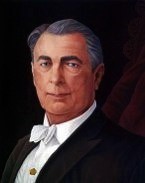
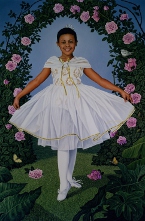

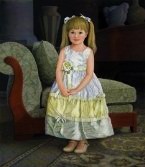
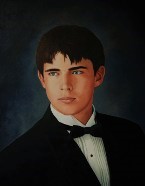
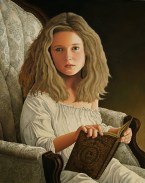
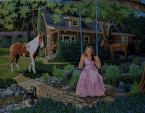
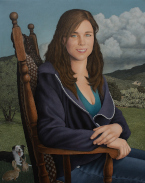
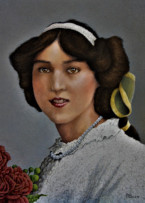
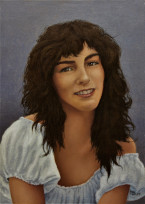

|
In
the beginning of Ron Marlett's career, he did not think of himself as a
portrait painter. The portrait genre gradually became interesting to
Ron as a source of income later in his life. A number of commissions
over the last few years have brought him an experience of capturing the
vitality of a subject. His
first attempt at a portrait painting was a self portrait he created in
1969. He created many portrayals of indigenous women in Hawaii during
the 1970s; these were presented in a show, and the experience allowed
him to build his expertise. By the early 1990s, Ron had become adept at
portrait presentation, and created a significant work: a portrait of
Robert E Lee which was widely accepted and used for the creation of limited-edition prints. In 2002, thirty-three years after his first self portrait, Ron created Self Portrait with a Hat,
in which he represented accurately the lines age had added to his face.
The work is powerful in its simplicity and honestly. To explore
Ron Marlett's portrait pieces, click on one of the pictures to the left.
Three Poems
This
essay was written by Ron Marlett to preserve his opinions about art
and his belief that the different art styles are bridges to
understanding humanity. |
In the art museums of cities far away, visitors walk through the
corridors that take them on a journey through time. The chronological
order of art allows visitors to appreciate artists' creative endeavors
in a historical perspective. Since the Renaissance, fundamental changes
in how artists have treated subject matter can be appreciated. In the
16th century, Pieter Breughel painted Landscape with the Fall of Icarus
(1558). Breughel's painting represented the Renaissance artists'
interest in realistic colors, three dimensional space, and mythological
themes. In the 17th century, Johannes Vermeer painted A Lady Writing
(1666). Vermeer's realistic portrait gives the impression of light
radiating from within the canvas rather than reflecting off the paint's
surface. During the post impressionist period, Vincent Van Gogh's
piece, Starry Night (1889),
captured the texture of the elements with thick gouges of paint.
These three paintings represent varied techniques and
philosophies of artists living in different times. Despite these
variations in painting styles, the three paintings have a unifying
thread. Each artist created art that has a tremendous amount of
emotional appeal embeded into the paintings' imagery. Everyones
emotional response to the artists' painting styles can be as diverse as
the paintings themselves. Wystan Hugh Auden, William Carpenter, and Don
McLean are three writers who gave unique responses to these paintings.
Each poem gives testimony to how the paintings affected the writer.
In Pieter Breughel's painting Landscape with the Fall of Icarus,
Breughel paints Icarus's death as an uneventful incident that no one
notices. The artist trivializes the tragedy by placing Icarus in the
far right side of the painting's background. Breughel focuses his
composition on farmers, fishermen, and sailors going about their daily
business - people who are completely oblivious to Icarus falling into
the ocean. Breughel's painting loudly proclaims, "A man dies and the
world hardly blinks." Wystan Hugh Auden made a more generous
interpretation in a poem entitled Musee des Beaux Arts (1938). Auden
wrote the poem after seeing Landscape with the Fall of Icarus
hanging in the Royal Museum in Brussels, Belgium. The emotional impact
the painting had on Auden enlightened him on how easy it is for people
to become apathetic toward others who are suffering. Auden writes:
In Breughel's Icarus, for instance: how everything turns away
Quite leisurely from the disaster; the ploughman may
Have heard the splash, the foresaken cry,
But for him it was not an important failure; the sun shone
As it had to on the white legs disappearing into the green
Water, and the expensive delicate ship that must have seen
Something amazing, a boy falling out of the sky,
Had somewhere to get to and sailed calmly on.
Breughel's painting of Icarus inspired Auden to think
about the ugly side of humanity. In 1938, Nazis were in control of
Germany and Auden was aware of Germany's hostility toward Jews. The
ones who read Auden's poem Musee des Beaux Arts
could have been inspired to participate in the destruction of Nazism in
an attempt to prove Breughel wrong. Auden's emotional response to
Breughel's painting of Icarus
inspired Auden to create a poem that, in turn , helped his
contemporaries make a choice between apathy and empathy in the wake of
Nazi cruelty. Like a painting's subject matter, poems can affect the
lives of people who read them. A writer's response to a painting does
not necessarily mean the poem will be a serious contemplation about
life. A humorous approach to poetry can also be valuable.
In William Carpenter's whimsical poem entitled Girl
Writing a Letter (1995), he tells a creative story about a thief
who steals a Johannes Vermeer painting from an art museum. The painting
that Carpenter describes in his poem is loosely based on Vermeer's A Lady Writing.
Carpenter brings the painting alive by having the thief enter into the
world of Vermeer's subject matter. The thief and the girl fall in love
with each other and the Girl Writing a Letter becomes the thief's
accomplice. The thief and the Girl Writing a Letter load up a black van
with stolin paintings and speed off into the night. Carpenter concludes
his poem by writing:
and when the thief puts her behind the wheel and says,
'Drive, baby, the night is ours,' it is the Girl Writing a Letter
who steers the black van onto the westbound ramp
for Storrow Drive and then to the Mass Pike, it's the
Girl Writing a Letter who drives eighty miles an hour
headed west into a country that's not even discovered
yet, with a known criminal, a van full of old masters
and nowhere to go but down, but for the Girl Writing a Letter,
these things don't matter, she's got a beer in her free hand,
she's on the road, she's real and she's in love.
William
Carpenter's poem Girl Writing a Letter is a comical parody about
teenage girls living at home with their protective parents; the girls
want to rebel against their parents and live out their fantasies with
dangerous boyfriends. By tapping into the teenagers' natural instinct
for self-reliance and independence, Carpenter's poem allows new
generations to make an emotional connection to art and thus to see art
as a source of inspiration for their creativity and imagination. Poems
about art help us to see the world we live in, but what about the
artists who created the art we admire? For many centuries female
artists were discriminated against by male dominated societies, and, to
this day, the majority of male artists suffer unfair prejudices because they are
financially unsuccessful. In Vincent Van Gogh's diary, the artist
complained regularly that none of his paintings sold and that his
brother had to send him money every month to pay for his rent, food,
and art supplies. Society ostracized Van Gogh, yet he still continued
to create art. He believed that what he was doing was importrant enough
to sacrafice his security, companionship, and well being in order to
contribute art to the world. Poems about art help us to develope respect for the individuals who devote
their lives to the arts.
The American folk singer Don McLean wrote a poem called Vincent
(1972) that pays tribute to the Dutch painter Vincent Van Gogh.
McLean's poem is about how the artist was rejected by society because
of his commitment to art. Van Gogh's passion to give beauty to the
world was met with people making jokes about his work, his sanity, and
his lack of success. McLean writes:
Now I understand
What you tried to say to me
How you suffered for your sanity
How you tried to set them free
They would not listen; they did not know how
Perhaps they'll listen now.
Since
Van Gogh's death, there have been art historians, critics, and writers
who have validated Van Gogh's work so that it is safe for people to
accept his art. In an indirect way, Van Gogh earned society's respect
because after his death, he recieved critical claim and his paintings
sold for millions of dollars. Van Gogh's paintings became successful
and he is now worthy of society's admiration. The hypocrisy of society
is that its acceptance of Van Gogh's art has nothing to do with the
reasons why he created it, but whether or not Van Gogh's art was a
financial
success. In the end of his poem, McLean suggests that modern society
still does not understand why Van Gogh painted:
Now I think I know
What you tried to say to me
How you suffered for your sanity
How you tried to set them free
They did not listen; they're not listening still
Perhaps they never will.
W H Auden, William Carpenter, and Don McLean are three
writers who have inspired others with their poems on art. Auden's
observance of apathy in Breughel's Landscape with the Fall of Icarus, Carpenter's creative approach to Vermeer's A Lady Writing, and McLean's psychosocial response to Van Gogh's Starry Night,
have made art accessible to people by focusing the complex world of art
into tangible sentences, words that inspire our creativity and
compassion by allowing us to make emotional connections to the art we
admire. The three poems become important parts of the paintings they
celebrate because the poems act as translators, subtitles to a visual
world that help us build bridges to our understanding of humanity.
lowered my fender
|
|


